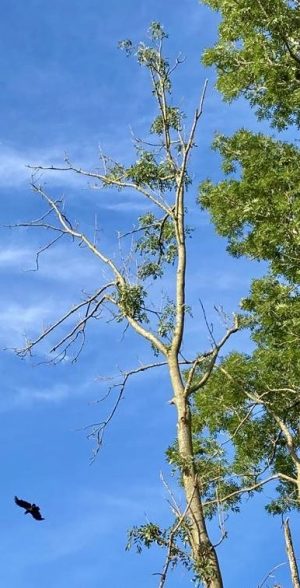Forests and woodlands – absorbing carbon dioxide?

Forests and woodlands are important in the global ecosystem; they have taken up some 20 to 30% of the carbon dioxide released from fossil fuels in recent times. It had been assumed that the dense and biodiverse tropical forest ecosystems (close to the equator) were particularly effective in ‘soaking up this carbon dioxide’. However, there is doubt that this will continue to be the case as forests shrink in size. Plus, recent work at the University of Birmingham (Dr Tom Pugh) has shown that where forests were re-growing, they took up large amounts of carbon partly because more carbon dioxide was available, but also as a result of the younger age of the trees. This ‘youthful’ carbon uptake was not associated with tropical areas, but with regenerating forests of more temperate regions.
Such regenerating areas include those in America’s eastern states; formed where early settlers farmed but then abandoned their farms and small holdings to move westward at the end of the 19th century. More land returned to forest after the great depression of the 1930’s. There has also been regrowth of boreal forest in parts of Canada, Russia and Europe - such areas have experienced extensive felling activity and /or forest fires. China has also replanted extensive areas. Important as the photosynthetic activity of these ‘temperate forests’ is in terms of climate mitigation, the research suggests that the effect of increased carbon uptake may be transient; in that once the period of vigorous growth is complete so the level of carbon uptake / assimilation will fall. It is therefore important to know about the life span of different trees, when they might die and what may cause their death.
Tree mortality (in terms of biomass) is associated with
 but with changing climate and global warming, the relative contribution that these factors may change with resulting changes in the age, make-up and biomass of forests. To discover more about tree death and the changing nature of forests and woodlands, a project called Treemort has been launched. This seeks to understand trends in tree mortality and the changing make-up of forests & woodlands, and how these in turn may affect carbon storage / sequestration. TreeMort will analyse a range of data sources including
but with changing climate and global warming, the relative contribution that these factors may change with resulting changes in the age, make-up and biomass of forests. To discover more about tree death and the changing nature of forests and woodlands, a project called Treemort has been launched. This seeks to understand trends in tree mortality and the changing make-up of forests & woodlands, and how these in turn may affect carbon storage / sequestration. TreeMort will analyse a range of data sources including
- forest inventories,
- satellite observations and
- plant trait data
Hopefully, such data will help create an overall picture of tree mortality rates and what drives the death of trees.
The INTREE project is also working towards a greater understanding of carbon storage by trees. This project involves studying the formation of woody tissue of trees - the xylem, partly through ‘traditional’ annual ring studies but by combining these with short term microscopic monitoring of weekly wood cuttings. The work focuses, in particular, on two conifer species - the Norway Spruce (Picea abies) and Black Spruce (Picea mariana) in the Alps and Canada. Some early work with the Black Spruce has indicated that warming and decreasing rainfall could adversely affect the xylem tissue (narrower vessels) leading to dieback. This could be symptomatic of the sensitivity of the boreal forests to climate change.
the FAO offers a number of interesting articles - for example on Forests and Climate Change - here
Comments are closed for this post.
Discussion
I’m trying to discover whether managing a woodland is likely to sequester more carbon than planting a new one. The article referred to above ‘the FAO offers a number of interesting articles – for example on Forests and Climate Change – here’ is good but out of date and the link to its source is not responding. Have you any better articles?
It’s the developers and local authorities that need to get it through their thick skulls that they must leave the countryside alone

Try using Google Scholar
https://scholar.google.com/
to search for published articles
Blogs
7 August, 2021